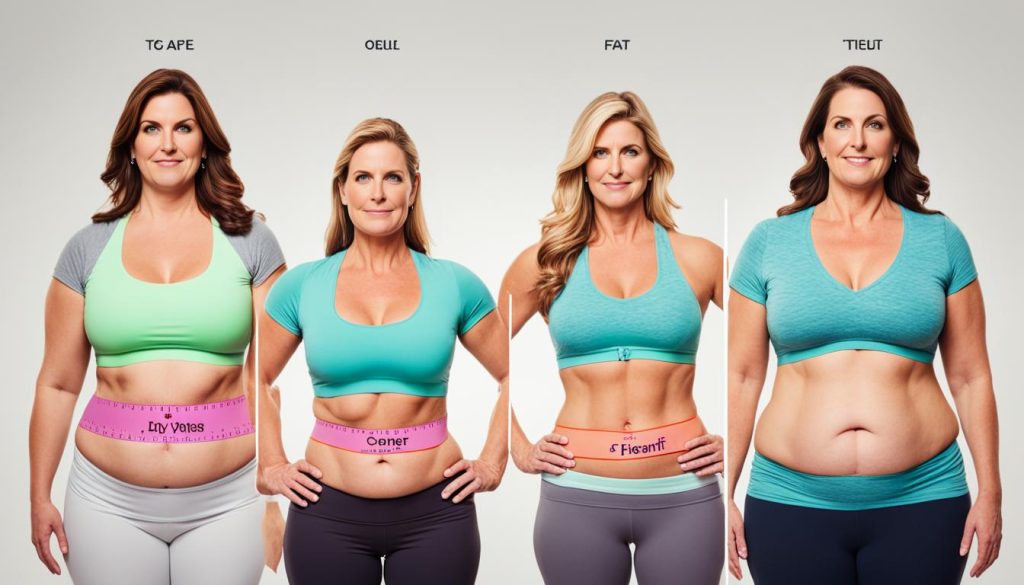Belly fat is tough for women to shed. Many women struggle with losing belly fat and wonder why. Knowing why it accumulates is crucial to tackling the issue.
Hormonal changes are a big reason belly fat sticks around. Menopause can make it worse due to estrogen changes. Age and genetics also affect it, reducing muscle mass and slowing metabolism over time.
Eating too many calories leads to more belly fat. If you consume more than you burn, the extra turns into fat around the stomach.
But belly fat is more than a beauty issue. It’s a health risk too. Excess belly fat can lead to serious problems like high blood pressure and diabetes.
Losing belly fat is hard, but not impossible. Eating right, exercising, getting enough sleep, and handling stress well can make a difference. These steps help women cut down belly fat and get healthier.
Key Takeaways:
- Hormonal changes, age, and genetics contribute to belly fat in women.
- Excess belly fat, especially the kind around organs, is a health risk.
- Eating well, staying active, sleeping enough, and managing stress help reduce belly fat.
- Women should focus on total health to tackle belly fat issues.
Factors Contributing to Belly Fat in Women
There are several reasons why women gain belly fat. Let’s look at these factors carefully:
Calorie Intake
Eating more calories than you burn leads to weight gain. This includes gaining belly fat. It’s crucial to watch how many calories you eat and aim for a balanced diet.
Age and Metabolic Rate
Getting older affects how easily women can keep a healthy weight. Loss of muscle and a slower metabolism play a part. Therefore, it’s important to exercise regularly. This should include cardio and strength training to help manage belly fat.
Genetics and Fat Storage
Your genes can affect your weight and where your body stores fat. Some people are more likely to store fat around their belly. This can make belly fat tough to lose.
Hormonal Changes
Changes in hormones, especially during menopause, can lead to more belly fat. These changes alter how your body handles fat and metabolism. This makes controlling belly fat a bigger challenge.
“The accumulation of belly fat in women can be influenced by various factors, including calorie intake, age, genetics, and hormonal changes.”
Understanding these factors is key to fighting belly fat. Women can tackle belly fat by eating healthily, exercising regularly, and making lifestyle changes. This way, they can reach their belly fat loss goals.
The Dangers of Visceral Fat
Understanding the dangers of visceral fat is key in fighting belly fat. Unlike subcutaneous fat, which is under the skin, visceral fat wraps around your organs. This can lead to serious health problems.
Excess visceral fat links to many health issues:
- High blood pressure: This type of fat produces substances that may raise blood pressure.
- Unhealthy blood lipid levels: It can mess up the balance of your blood fats, affecting cholesterol and triglycerides.
- Sleep apnea: Too much belly fat can boost the risk of sleep apnea, where breathing stops and starts as you sleep.
- Heart disease: Visceral fat ups the risk of heart attacks and heart disease.
- High blood sugar and diabetes: It can mess with insulin and up your risk for diabetes.
- Certain cancers: There’s a link between belly fat and some cancers, like colorectal and breast cancer.
- Stroke: Visceral fat is tied to a higher chance of stroke.
- Fatty liver: It contributes to fat buildup in the liver, causing nonalcoholic fatty liver disease.
- Early death: Too much visceral fat is linked with a higher risk of dying early.
To fight belly fat, it’s crucial to target both subcutaneous and visceral fat. Let’s look at ways to lose belly fat and boost health.

The Relationship Between Visceral Fat and Subcutaneous Fat
Understanding visceral and subcutaneous fat is crucial. Visceral fat is deep inside, wrapping around vital organs. This makes it very dangerous.
Subcutaneous fat is right under the skin. It’s less harmful but can still affect your appearance. While both are in the belly, visceral fat is more risky because of its location and the substances it makes.
Reducing both types of fat through healthy lifestyle choices can lower health risks. It can also lead to a flatter, toned belly.
| Type of Fat | Location | Health Risks |
|---|---|---|
| Visceral Fat | Deeper in the abdomen (surrounding organs) | High blood pressure, unhealthy blood lipid levels, sleep apnea, heart disease, high blood sugar and diabetes, stroke, fatty liver, early death |
| Subcutaneous Fat | Just beneath the skin | Minimal health risks, primarily a cosmetic concern |
Now, let’s explore how to shed belly fat and improve our well-being.
How to Measure Belly Fat
Measuring waist circumference is crucial for females to understand belly fat levels. It’s an easy and helpful way to gauge your abdominal fat. This method gives you a basic idea of your belly fat.
To measure your waist, just follow these steps:
- Stand straight with your feet shoulder-width apart.
- Place a tape measure around your bare stomach, just above your hipbone.
- Pull the tape snugly, but not too tight, to get an accurate measurement.
- Ensure the tape measure is level all the way around your waist.
For women, a waist size over 35 inches means there’s an unhealthy level of belly fat. But, remember, waist size alone doesn’t show your overall health. It doesn’t tell all about fat distribution in the body.
Digging Deeper: Subcutaneous and Visceral Fat
Knowing your waist size is useful, but understanding the types of belly fat is key. Women typically carry both subcutaneous and visceral fat.
Subcutaneous fat: This type sits right under the skin, making the belly feel soft. Though it’s seen as less risky, it’s not without harm.
Visceral fat: This fat wraps around internal organs, raising the risk of serious health issues. It’s connected to heart disease, diabetes, and some cancers.
Measuring your waist is a starting point. To fully understand your fat distribution and health, talk to a healthcare expert. They can evaluate your body composition and offer advice tailored to you.

| Measurement | Health Risk |
|---|---|
| Less than 35 inches | Healthy range |
| 35 inches or more | Unhealthy amount of belly fat |
Strategies to Reduce Belly Fat
To effectively reduce belly fat, women should focus on healthy lifestyle changes. A nutritious diet and regular exercise are key. These steps will help you reach your goals in a lasting and effective way.
1. Healthy Diet
Maintaining a balanced diet is crucial for losing belly fat. Eat lots of fruits, veggies, whole grains, and legumes. They are full of fiber and nutrients, aiding weight loss.
Include lean proteins like poultry, fish, tofu, and beans too. Protein repairs muscles, boosts metabolism, and helps burn belly fat.
Also, cut down on saturated fats. Choose healthier fats found in avocados, nuts, and olive oil instead. These good fats can help reduce inflammation.
2. Portion Control
Controlling how much you eat is vital. Pay attention to portion sizes and stop eating when you’re full. Don’t overeat.
Try swapping sugary drinks for water or sugar-free alternatives. Sugary beverages add lots of calories, leading to weight gain and more belly fat.
3. Regular Physical Activity
Regular exercise is critical for calorie burning and cutting down belly fat. Try to get at least 150 minutes of moderate aerobic activity each week.
Strength training is also key. It builds muscle, which increases metabolism and supports fat loss. Add exercises like planks and crunches to target abs.
4. High-Intensity Interval Training (HIIT)
HIIT workouts are great for fighting belly fat. They mix intense exercise bursts with rest. This method boosts your heart rate and burns calories efficiently.
HIIT also triggers the afterburn effect. This means your body keeps burning calories even after the workout ends.
5. Stay Consistent
Being consistent is crucial in reducing belly fat. Stick with your healthy diet and workouts, even if results aren’t instant. Change takes time.
Keep yourself motivated by setting realistic goals, tracking your progress, and celebrating small wins. This will help you stay on track.
By applying these strategies, you can manage your belly fat and enhance your health. It’s all about making smart choices every day.
The Role of Sleep and Stress
Getting enough sleep and managing stress are key to losing belly fat. Studies show that 6 to 7 hours of good sleep each night helps keep visceral fat away. This is the harmful fat around organs. Too little or too much sleep increases belly fat in women.
It’s also vital to manage stress to stay at a healthy weight and lessen belly fat. High stress can lead to cortisol release, which stores fat in the belly. Working on stress reduction can prevent weight gain and fat buildup.
Natural methods can improve sleep quality and lower stress, aiding belly fat loss. Activities like meditation, yoga, or deep breathing are beneficial. Also, being outdoors and enjoying nature helps with sleep and stress.
Exercise is great for cutting belly fat and enhancing sleep and stress. Moderate activities like walking or biking melt calories and improve sleep. Strength training builds muscle, boosts metabolism, and helps in losing weight.
A comprehensive strategy is needed to lose belly fat quickly. This includes enough sleep, managing stress, and regular workouts.

Understanding Body Fat Distribution
Many women find losing belly fat tough. This struggle often relates to how body fat spreads differently among people. Genetics, hormones, and body composition matter a lot here. Knowing this can help find the right ways to lessen belly fat.
There are mainly two patterns of fat distribution: apple-shaped and pear-shaped. Apple-shaped people have more belly fat, while pear-shaped people have fat around their hips and thighs. For women, being apple-shaped means a higher risk of carrying visceral fat. This is the fat around your organs.
Visceral fat is worrying not just because of how it looks. It’s linked to serious health issues like heart disease, diabetes, and some cancers.
So, why is belly fat so hard to lose for females?
Belly fat is tough to lose because it’s not only the fat under the skin. It includes visceral fat too, which is harder to get rid of. While you can lose some fat with exercise and eating less, visceral fat needs a broader approach for significant loss.
Targeting just the belly for fat loss doesn’t work. A better strategy is an overall weight loss plan. This should include healthy living habits and specific exercises.
The Role of Exercise in Reducing Belly Fat
Staying active is key to fighting belly fat and managing weight. Mixing aerobic activities, strength training, and belly exercises can increase muscle, burn calories, and reduce fat.
“It is well-established that abdominal exercises alone will not specifically reduce belly fat in women. The key lies in combining overall body fat reduction with targeted exercises to strengthen and tone the abdominal muscles.”
Exercises like running, swimming, or biking help burn calories for overall fat loss. Lifting weights or doing bodyweight exercises builds muscle, which burns more calories. Mixing cardio with strength training is the best way to lose belly fat.
| Recommended Exercises to Target Belly Fat | Duration/Frequency |
|---|---|
| Brisk walking | 30-60 minutes, 5 days a week |
| Running or jogging | 30-45 minutes, 3-4 days a week |
| Resistance training | 2-3 days a week, targeting major muscle groups |
| Abdominal exercises (planks, crunches, etc.) | 2-3 days a week, as part of a full-body strength training routine |
Adding high-intensity interval training (HIIT) to your routine can also help lose belly fat. HIIT mixes intense exercise bursts with short breaks, which boosts calorie burn and fat loss.
Healthy Eating and Belly Fat Reduction
Eat a balanced, calorie-smart diet alongside your exercise plan. Choose whole, unprocessed foods like lean proteins, fruits, veggies, whole grains, and healthy fats.
Watch your portion sizes and don’t overeat. Extra calories lead to weight gain and more belly fat. Switch sugary drinks for water or herbal tea to aid weight loss.
Remember, losing belly fat requires a multi-faceted approach that combines healthy eating with regular exercise. It is essential to consult a healthcare professional or registered dietitian to create a personalized plan that suits your individual needs and goals.

Understanding body fat distribution and making lifestyle changes can help women reduce belly fat. It’s a journey towards better health and well-being.
The Health Risks of Excess Belly Fat
Excess belly fat ups the risk of many health issues. Heart disease and stroke are closely linked to it. Visceral fat also connects to asthma, some cancers like colorectal and breast, type 2 diabetes, and more.
Belly fat is more than a cosmetic issue; it hits health hard. Fat cells in the belly area release harmful substances. These can cause chronic inflammation, mess with hormones, and harm the body in other ways.
The Impact on Heart Health
Too much belly fat raises your chance of heart disease. Visceral fat makes substances that cause inflammation. This can harm blood vessels and lead to atherosclerosis. It also messes with your cholesterol levels.
Connection to Type 2 Diabetes
Belly fat in women is strongly linked to type 2 diabetes. It lets out fatty acids and hormones that block insulin. This can make blood sugar levels spike and may cause diabetes over time.
Increased Cancer Risk
Research shows belly fat might lead to cancers like colorectal and breast. Experts believe that the activities of visceral fat cells play a role in this risk.
Asthma and Lung Function
Having a lot of belly fat can affect your breathing and lead to asthma. The fat presses on your lungs and diaphragm, making it hard to breathe. It also releases chemicals that can make asthma worse.
Mental Health and Cognitive Function
Excess belly fat might hurt your brain health, leading to dementia and thinking issues. Belly fat causes inflammation and insulin problems, which are bad for the brain.
“Tackling excess belly fat is key for reducing health risks and boosting overall health.”
Knowing the dangers of belly fat can drive people to cut it from their lives. Eating well, exercising, managing stress, and getting enough sleep can all help. Together, they reduce belly fat and cut down on health risks.
How to Assess Visceral Fat Levels
To gauge your visceral fat without costly scans, you can try simpler methods.
Measuring your waist circumference is a quick way to estimate visceral fat. A bigger waist usually means more visceral fat. For women, over 35 inches around the waist signals a problem.
The Body mass index (BMI) is also used to guess how much body fat someone has. It might hint at visceral fat amounts. Yet, BMI doesn’t tell the whole story on its own. Look at it with other health markers.
Talking to a doctor for a detailed visceral fat evaluation is best. They can do tests and give you advice tailored to you.
Visceral fat is linked to many health issues. It’s key to be aware and take action to control it.
Conclusion
Losing belly fat is a tough job for women. Many things like what we eat, our age, family traits, and hormone levels play a part. Belly fat is not just about looks; it’s a danger to our health because of the diseases it can cause.
To tackle this, mix healthy food choices with exercise, good sleep, and less stress. Changing how we live can really make a difference. Remember, changing your body takes time and hard work. You need to stay on track.
Try out these tips for shedding belly fat. It could make you healthier and happier. Decide to take care of your health from now on. With patience and the right steps, reaching your health goals is possible. You’ll feel better for it.




